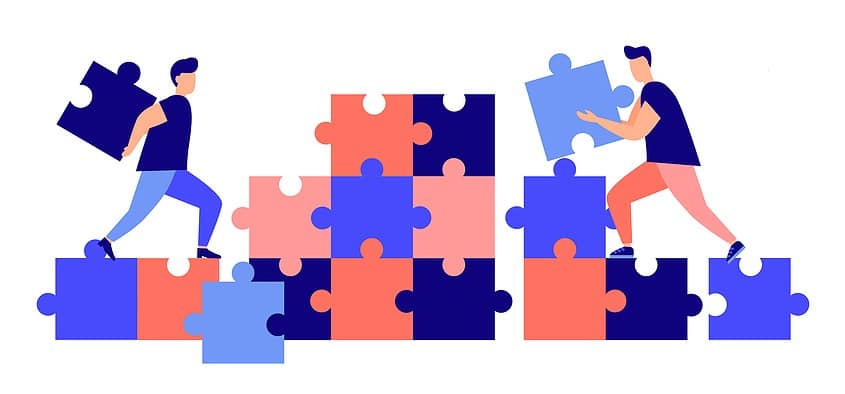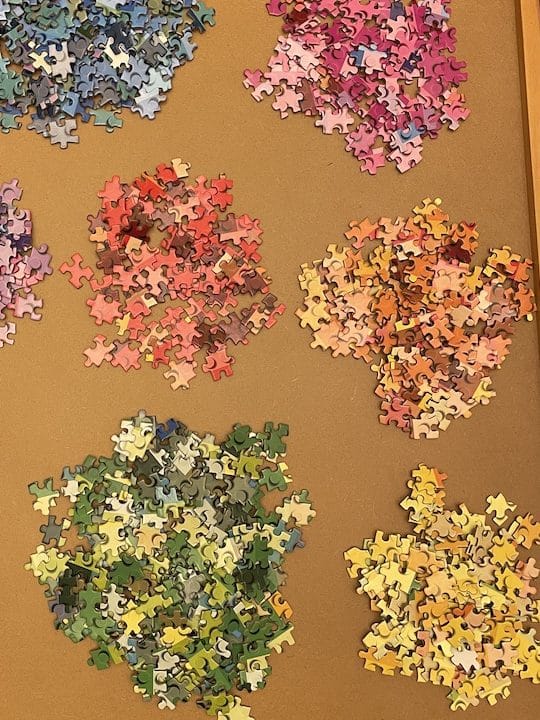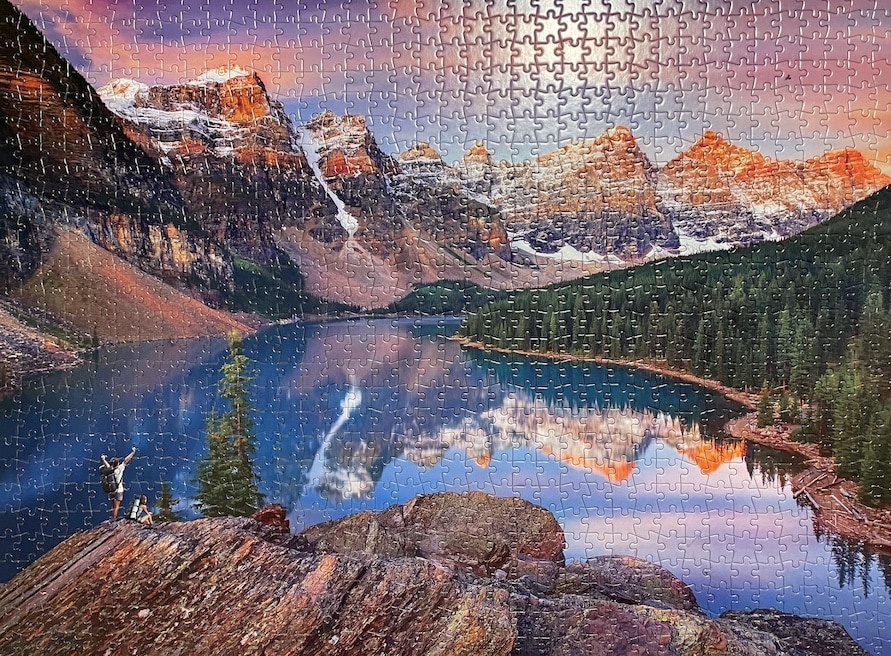
Jigsaw puzzles can seem like a daunting task of random chance to those who are uninitiated in its intricate ways. Large jigsaws have many hundreds or even thousands of pieces. The largest commercially available jigsaws can reach into the tens of thousands of pieces. How do you even begin to work with that? Let’s look at some jigsaw puzzle tips.
The fact is that jigsaws need to be solved with careful strategy and a considered approach. It absolutely is not a case of simply taking up one piece and then checking it against all the other pieces in the set to find one that fits. In today’s article, we’re looking at six effective strategies that will help you to conquer just about any jigsaw puzzle.
Table of Contents
Strategy 1: Sort the Edge Pieces First
One of the most popular and effective strategies for getting started with a jigsaw puzzle is to first sort through and assemble the edge pieces. This is an effective approach because even in a larger and more complex puzzle, the edge pieces are easy to spot because of that distinctive straight side.
It’s easy, therefore, to sift through pieces of any size and come up with the edges. Once you have those in their own separate pile, you have a much smaller number of pieces that you know all will connect together to form the frame of your final image. Getting that framework is a confidence-boosting start and gives you multiple starting points from which to apply some of the other strategies that you see below.
Strategy 2: Sort the Color Groups

Another sorting approach is to look at the colors of the pieces and arrange them into groups by referring to the image on the box. This doesn’t work with all images, but it’s good for any image with a distinctive color pattern or depiction of specific activities or people. For instance, a jigsaw depicting a circus or carnival scene would likely contain very distinctive color groups. On the other hand, an image of a forest with many similar-looking trees and rocks in the foreground would be harder to group just by color alone.
Even if you can only get very limited grouping using these methods, you can still take a step in the right direction and get some of your pieces sorted into a more useful and connected pile. For example, if you are doing a puzzle that contains faces, then pieces belonging to the faces should be quite distinct from background pieces and you can at least get some of the pieces sorted this way. As they say, “every little bit helps.”
Strategy 3: Work from the Corners Outward
This strategy goes very well with strategy number 1 of first sorting and assembling the edge pieces. If you have completed strategy one, then you have four corners ready and can take your pick as to which one you wish to work from. Choose a corner and steadily work out methodically from that corner while all the time referring back to the main image on the jigsaw box.
In some jigsaws, it could be that two corners have quite similar backgrounds, and so you might apply your color grouping strategy here. For instance, let’s say you’re completing a jigsaw that is depicting a beach scene. The top two corners of the scene are likely to be sky and sea, and the bottom two corners more likely to be sand or land-based nature. You can therefore pick a “half” to work on first rather than just one corner. All the bluer pieces (assuming it’s a blue-sky background) will go in that top half, and the beige, brown, and green tiles will likely go on the bottom half.
However you finally make it work, having corners to work from is a great strategy, and it complements multiple other strategies, as we have shown.
Strategy 4: Begin with High-Contrast Areas
When we say “high-contrast” areas, what we’re referring to are obvious and clear features that you can identify by referring to the original image on the box. This strategy works quite well with the color-grouping strategy. Here are some examples of pieces that will often contain high-contrast features:
- Text – it could appear on a sign or poster in the background of the image
- Buildings – they often have architectural features that highlight their distinct shape or color such as windows, doors, chimneys, aerials, and more
- People’s faces – look for distinct smiles, eyes, noses, etc.
- Animal forms – especially animals of distinct color patterns like zebras, tigers, giraffes, etc.
- Slopes or peaks of mountains, or the tops of trees, etc.
When you get these areas done first, you create more space on your table to spread out the more monotone areas of background for things like sky, water, grass, or sand. These usually don’t contain much in the way of high-contrast features and so are best left until later when you can have the space to spread the pieces out and study the shape of their connections.
Strategy 5: Work in Small Sections
Just as the puzzle is divided up into these tiny pieces, you can also divide the puzzle up into sections or “quadrants.” This doesn’t mean necessarily drawing arbitrary straight lines across and down the box and forming a grid. You can take a more considered approach to how you divide the puzzle depending on what the image is that you are working on.
You could divide it into quarters, thirds, or some other fraction, or you could organize it according to features and “region” of the image. That ties in well with some of the other jigsaw puzzle tips that we have described above. The key, however, is to not make any one section too large and try to make sections distinct and easy to identify.
Whatever way you decide to divide it, working in smaller sections will likely help you to complete a jigsaw puzzle faster. Through a series of small victories, you can more quickly and effectively reach your final goal.
Strategy 6: Mix it Up
Finally, another thing you can do is mix it up and apply multiple strategies. In truth, a single approach won’t get you to the end of the puzzle. You’ll have to mix and match different approaches to get through every part of the image. The key is to see which strategies blend well together. Above we touched on some of the strategies that work well as an ensemble.
For instance, strategies 1 and 3 work very well in tandem. Start by sorting the edge pieces and assembling the frame of the image. The result of that is you have 4 corners from which to work and you, therefore, have given yourself multiple options with which to work. Combining strategies will increase their effectiveness, and help you to defeat even the most difficult puzzle.
Conclusion: Build a Strategy, Complete the Puzzle
Having a strategy for your jigsaw puzzle approach is enormously beneficial. With smaller puzzles, the strategies become simpler, but the principles remain the same. It’s a good idea to practice these strategies and approaches with smaller, simpler puzzles before moving on to the huge complex puzzles of 1,000 pieces or more. If you bite off more than you can chew, you are dooming yourself to many days of potential frustration.
Bonus
There is one bonus addition to our jigsaw puzzle tips that we can offer you. When formulating a jigsaw strategy is to always keep in mind bringing in a set of fresh eyes if and when you get stuck. There are times when you have been staring at the puzzle for so long that it starts to lose all meaning in your eyes, and you miss even the most obvious signs of how to move forward. A set of fresh eyes can help you there, so keep that as a “plan b” just in case.
We hope these jigsaw puzzle tips help you with solving jigsaw puzzles! Enjoy your jigsaw time, and reap the long-term benefits.

